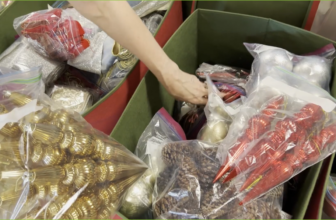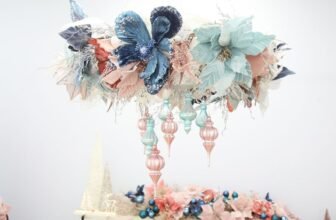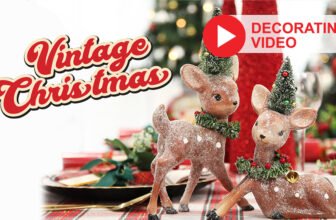
Last updated:
Christmas is a time of tradition and customs that are rooted in both religion and culture. Rooted in ancient practices of celebrating the mid-winter in the northern hemisphere, Christmas is a celebration for all kinds of people as well as for those practising the Christian faith around the world.
One of the fascinating things about Christmas is the vast array of traditions and practices that so many people enjoy during the season. Almost all of us will have some kind of familiarity with Christmas traditions from opening advent calendars in December to leaving out cookies for Santa Claus, or singing hymns and carols.
We have collated a long list of Christmas Traditions and Christmas Customs. Each tradition listed has a short explanation and is also linked to a longer article that details more about that particular custom.
48 Christmas Traditions and Customs
12 Days of Christmas
12 Days of Christmas – The 12 Days of Christmas is a fun holiday tradition that spans from December 25th to January 5th, celebrating the festive season with an extended period of merrymaking and gift-giving. Rooted in Christian beliefs, this custom symbolises the time between the birth of Jesus Christ and the arrival of the Magi, or the three wise men, who brought him gifts.
Advent
Advent – Advent is a four-week period leading up to Christmas, observed by many Christian denominations as a time of spiritual anticipation and preparation for Christ’s birth. Marked by traditions such as the Advent calendar and wreath, its focus is on hope, anticipation, and reflection. Despite varied practices among different denominations, Advent universally signals the start of the festive season, having a significant impact on culture and society.
Boxing Day
Boxing Day – Boxing Day, celebrated on December 26th, originated in Britain during the Middle Ages as a day to distribute collected alms to the poor. Over time, it evolved into a day for giving gifts to servants and tradespeople. Today, the holiday is marked by various traditions such as gift-giving, shopping sales, sporting events, charity work, and outdoor activities, fostering a sense of community and generosity across countries with ties to the Commonwealth.
Christmas Bells
Christmas Bells – The tradition of Christmas bells dates back centuries and carries significant religious and cultural meaning. Their joyful ringing symbolises the celebration of Jesus Christ’s birth, spreads happiness, and is closely associated with Santa Claus and his sleigh. Bells take various forms during the holiday season, including church bells, sleigh bells, hand bells, and decorative ornaments, all contributing to the magical atmosphere of Christmas.

Christmas Candles
Christmas Candles – Christmas candles, with roots in ancient pagan practices, have evolved into a significant symbol of light, warmth, and hope in various cultures worldwide. Customs such as the German Advent wreath, the Irish candle in the window, French La Fête des Lumières, and Jewish Hanukkah are just a few examples of how candles are used to celebrate the festive season. These customs demonstrate the diverse and enduring traditions that connect people across generations and cultures, all while celebrating the central themes of light and unity during Christmas.
Candy Canes
Candy Canes – The candy cane, a traditional Christmas symbol with a history dating back to 17th century Europe, is a flavoured candy with distinctive red and white stripes. Often linked to folklore, the candy cane’s ‘J’ shape is said to represent a shepherd’s crook or the name of Jesus, while the white and red stripes symbolise purity and Christ’s sacrifice respectively. Its popularity in America grew in the 19th century due to German immigrants, and by the mid-20th century, it was a common sight during the holiday season. Today, candy canes are hung as ornaments, used in holiday crafts and recipes, and feature in festive events like “candy cane hunts,” making them an integral part of Christmas celebrations.
Chrismons
Chrismons – Chrismons are Christian symbols used as Christmas decorations, originating from the Lutheran Church in the 1950s. They are usually white and gold, symbolising Jesus’ purity and majesty. The symbols, such as the cross, fish, Alpha and Omega, among others, each have specific Christian significances. These decorations are used to highlight the Christian nature of Christmas, often accompanying the telling of the stories behind each symbol.
Christmas Cake
Christmas Cake – The tradition of the Christmas cake originates from medieval England, evolving from a porridge-like dish to the rich, fruity cake we know today, with significant influences from the Victorian era. A key part of the tradition is “Stir-up Sunday,” the last Sunday before Advent, when families would gather to mix the cake. The cake often includes symbolic elements, such as 13 ingredients for Jesus and his apostles, and a coin for good luck. Variations of the Christmas cake exist around the world, such as Japan’s sponge cake, Italy’s Panettone, France’s Bûche de Noël, and Germany’s Stollen.
Christmas Cantata
Christmas cantata – A Christmas cantata is a music composition combining voice, instruments, and often a choir to narrate the story of Christ’s birth, originating in the early 17th century. Cantatas feature thematic material revolving around the nativity and can range from traditional classical to contemporary music styles. Today, these cantatas are performed during the Christmas season, serving as a unifying and reflective tool to contemplate the spiritual significance of Christmas.
Christmas Carols
Christmas carols – Christmas carols originated from the tradition of “carols,” circle dances accompanied by songs during Roman times. These songs later became associated with Christmas through Latin hymns in early Christian Church services. The tradition evolved in the Middle Ages when carols were used for storytelling, and Francis of Assisi further popularised them through Nativity plays. The Victorian era saw a revival of carols, many of which are still sung today. Christmas carols differ across cultures and are central to the tradition of caroling. The tradition continues to evolve in the modern era, with new songs becoming holiday staples.
Christmas Cards
Christmas cards – The tradition of sending Christmas cards dates back to the 19th century, initiated by Sir Henry Cole in the UK. The tradition gained popularity with advancements in printing technology and reduced postal rates. Over time, Christmas cards evolved from generic winter scenes to more explicit holiday themes. Today, they come in various designs and formats, including handmade, store-bought, and electronic versions. Despite changes and modern adaptations, the essence of the tradition – expressing love, gratitude, and holiday cheer – remains the same.
Christmas Eve
Christmas Eve – Christmas Eve, celebrated worldwide on December 24th, marks the culmination of the Advent season and the eve of Christmas Day. Its origins trace back to the early Christian Church and the 4th-century decision to recognise December 25 as the birth of Christ. This day is significant in the Christian faith, marking the anticipation of Jesus Christ’s birth. Traditions and customs vary globally, including attending Midnight Mass, gift-giving, feasting like the Italian-American ‘Feast of the Seven Fishes’, caroling, tracking Santa’s journey, and hanging stockings. All these contribute to the magic and joyous anticipation of Christmas, making Christmas Eve a cherished time of reflection, togetherness, and celebration.
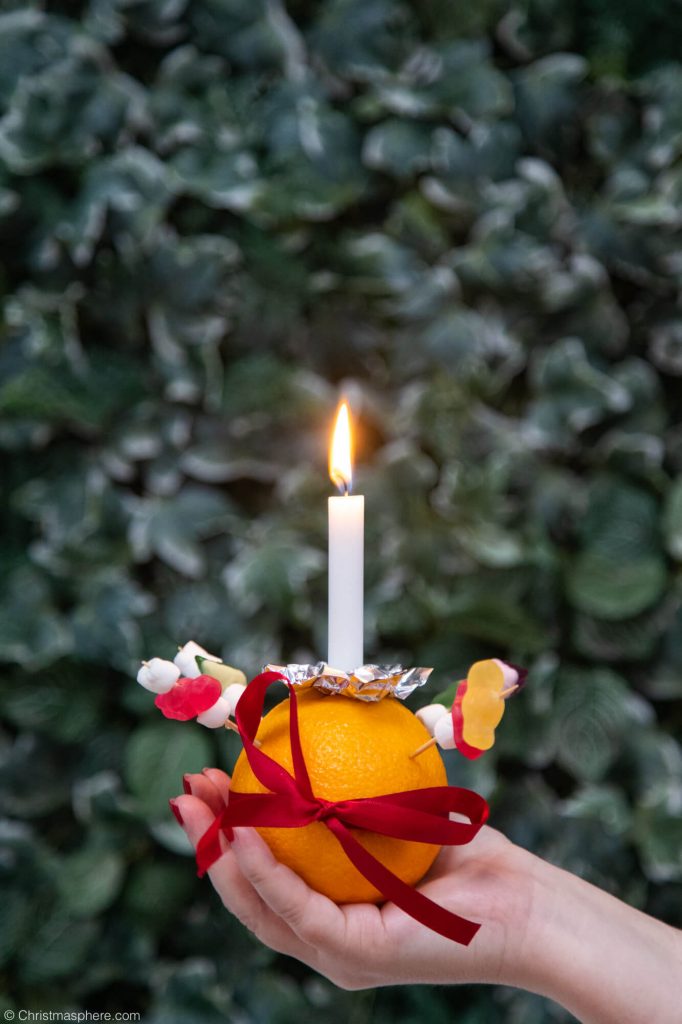
Christingle
Christingle – A Christingle is a symbolic tradition in Christian celebrations, especially during Christmas. It consists of an orange representing the world, with a candle on top symbolising the light of Christ. Other elements like sticks with fruits, a red ribbon, and sometimes a paper frill are added, representing the seasons, God’s love, and righteousness. Christingles are used in church services and family gatherings to signify the arrival of Jesus as the light of the world, bringing hope and salvation.
Christmas Crackers
Christmas Crackers – Christmas Crackers, invented in 1847 by London sweet maker Tom Smith, are a cherished holiday tradition, particularly in the United Kingdom. Smith was inspired by the crackling sounds of his fireplace and decided to create a product that would offer a similar surprise. Initially filled with sweets, the contents of the crackers evolved over time to include small toys, trinkets, jokes or riddles, and the iconic paper crown. Today, these festive accessories are not just decorative table placements but symbols of unity and togetherness, adding joy and laughter to Christmas celebrations around the world.
Christmas Colours
Christmas colours – The colours of Christmas — red, green, gold, white, blue, and silver — each carry rich, symbolic meanings tied to centuries of tradition and belief. From the sacrificial love symbolised by red, to the purity and peace denoted by white, each colour enhances our understanding and appreciation of the holiday season. Remembering these meanings can deepen our connection to Christmas, reminding us of the enduring themes of love, life, wealth, purity, and peace that truly make the season special.
Christmas Pickle
Christmas Pickle – The Christmas Pickle is a peculiar tradition involving a pickle ornament hidden in a Christmas tree, with the finder receiving good luck or an extra gift. Despite being widely attributed to Germany, most Germans are unfamiliar with it, leading some to speculate that it was a marketing strategy by 19th-century ornament sellers. Regardless of its origins, the tradition has gained popularity, particularly in the U.S, adding a unique and playful element to holiday festivities.
Christmas Pudding
Christmas pudding – Christmas pudding is a traditional British dessert rich in history and cultural significance, often made with thirteen ingredients symbolising Jesus and his twelve apostles, and served aflame. The pudding, made weeks or even a year in advance, may include small tokens or “charms” for guests to find, and is frequently presented with a sprig of holly. Its numerous traditions and modern adaptations continue to make it a central symbol of Christmas celebration in Britain and other parts of the world.
Christmas Market
Christmas markets – Christmas markets are a festive tradition that originated in the Late Middle Ages in the German-speaking regions of Europe. Initially winter markets for locals to stock up on supplies, they have evolved into grand celebrations with vendors selling Christmas-specific goods, food, and crafts, and featuring various forms of entertainment. Today, these markets not only boost local economies worldwide, but also serve as a platform for communities to come together, and for artisans to showcase their crafts, embodying the spirit of the holiday season.
Christmas Stockings
Christmas stockings – The tradition of Christmas stockings, believed to originate from the benevolence of Saint Nicholas, involves hanging stockings or similar items by the fireplace on Christmas Eve to be filled with small gifts. Over time, this practice has been adapted globally with unique cultural variations and the stockings, once everyday socks, have evolved into specialized, often personalized, decorations. Despite its evolution, the tradition maintains its initial spirit of generosity and care, symbolising the joy of gift-giving during the holiday season.

Christmas Tree
Christmas tree – The tradition of the Christmas tree dates back to the 16th century in Germany, where people would bring evergreen trees into their homes and decorate them with candles, apples, and other ornaments. Over time, the practice spread to other parts of the world and became a beloved symbol of Christmas, representing life, renewal, and the festive spirit of the holiday season.
Christmas Village
Christmas Village – The tradition of the Christmas village decoration, or putz, originates from European culture and involves creating miniature holiday-themed dioramas. These setups often contain a mix of secular and religious elements, ranging from buildings and figures to nativity scenes, all intricately arranged on mantels, tables, or special platforms. This cherished practice offers a unique, tangible way to connect with the festive spirit, historical roots, and religious aspects of the Christmas season.
Eggnog
Eggnog – Eggnog is a traditional Christmas drink with origins in medieval Europe that symbolises celebration, prosperity, and togetherness. Typically made with milk, cream, sugar, eggs, and spirits, it has modern and international variations to cater to a variety of tastes and dietary needs. Ensuring its safe preparation and enjoying its rich, comforting flavours during the festive season continue to make eggnog a cherished part of Christmas traditions worldwide.
Elf on the Shelf
Elf on the Shelf – The Elf on the Shelf is a cherished Christmas tradition involving a scout elf sent by Santa Claus to monitor children’s behaviour. Each day, the elf observes the family and flies back to the North Pole each night to report to Santa, then chooses a new spot in the house to sit, creating a delightful daily game of hide-and-seek. This tradition fosters a sense of excitement and anticipation for Christmas, while promoting good behaviour among children.
Gift-giving
Gift-giving – The tradition of Christmas gift-giving blends ancient pagan practices, Christian lore, and modern commercialism, with origins in the biblical story of the Three Wise Men and the Roman festival of Saturnalia. Over time, the custom evolved from a primarily social obligation to an expression of love and goodwill, becoming significantly commercialised in the 19th and 20th centuries. Despite varying global practices and commercial aspects, the essence of Christmas gift-giving remains a celebration of generosity and a manifestation of affection towards loved ones.
Gingerbread House
Gingerbread houses – Gingerbread houses is a tradition originating from 16th century Germany that have become an integral part of Christmas celebrations worldwide. This edible craft, bringing together family members in a fun, creative activity, symbolizes warmth, home, and togetherness during the holiday season. Embracing the magic of this tradition can add a special touch to your festive celebrations, embodying the sweetness and joy of Christmas.
Holly, Ivy, and Evergreen Plants
Holly, ivy, and evergreen plants – The tradition of using holly, ivy, and evergreen plants during Christmas dates back to ancient pagan rituals, symbolising eternal life and the resilience of nature through winter. These symbols were later incorporated into Christian celebrations, with holly representing the crown of thorns worn by Jesus and ivy signifying resurrection. Today, these plants continue to be a fundamental part of Christmas decorations globally, adding colour, life, and historical significance to the holiday season.
Jesse Trees
Jesse Tree – The Jesse Tree, rooted in biblical prophecy and medieval art, represents the genealogical line from Jesse, King David’s father, to Jesus Christ, symbolising the continuity of the Bible’s narrative. In modern Christmas celebrations, it serves as a devotional tool during Advent, with each ornament added daily representing a biblical story, aiding in understanding the anticipation of Advent and the story of salvation. Creating a Jesse Tree can be a rewarding family tradition, offering an engaging way to delve into biblical stories and the significance of the Christmas season.
Midnight Mass
Midnight Mass – Midnight Mass is a timeless tradition celebrated globally on Christmas Eve, symbolising the birth of Jesus Christ into the world. Its roots trace back to the early years of Christianity and it holds deep theological and symbolic significance. This blog post explores the origins, significance, rituals of Midnight Mass, and provides tips for first-time attendees, emphasising that this tradition, regardless of one’s faith, offers a profound sense of community, joy, and peace during the holiday season.
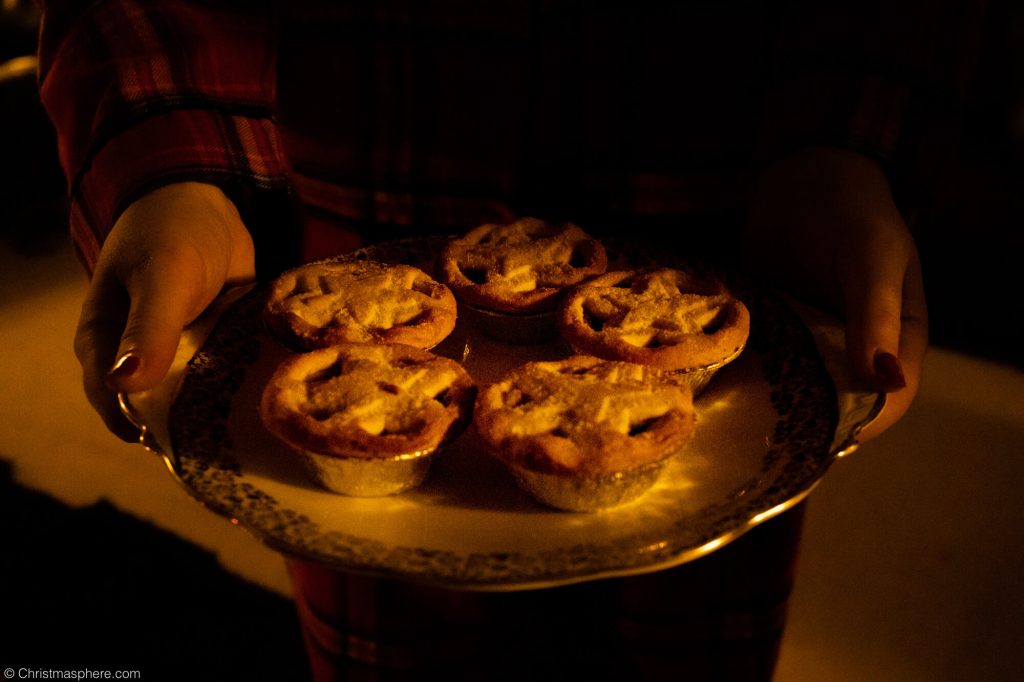
Mince pies
Mince pies – Mince pies, a treasured Christmas tradition, trace their roots back to the Middle Ages, evolving from large, meat-filled pastries to today’s sweet, palm-sized pies rich with dried fruits and spices. Despite changes in size and ingredients, and even facing prohibition in the 17th century, mince pies have remained a resilient symbol of festive cheer, enjoyed around the world. Eating these pies during the holiday season is considered to bring good luck, making them not just a treat, but a delightful part of Christmas history.
Mistletoe
Mistletoe – The tradition of mistletoe dates back to ancient times, where it was believed to have mystical and healing powers. In Norse mythology, mistletoe was associated with love and friendship, leading to the custom of kissing under the mistletoe during the holiday season. Today, mistletoe remains a cherished tradition during Christmas, symbolising love, goodwill, and the spirit of the season.
Mummering
Mummering – Mummering is a unique folk tradition originating from the British Isles and now commonly associated with Newfoundland and Labrador in Canada. This practice occurs during the holiday season, with participants, known as mummers, dressing in elaborate disguises and visiting neighbours’ homes to entertain through song, dance, or plays.
The Nativity
Nativity – The Nativity, a depiction of the birth of Jesus Christ, is a key tradition of Christmas, dating back to the 13th century. It involves a variety of figures including Mary, Joseph, Baby Jesus, shepherds, Wise Men, and angels, each with their own symbolic meanings. The tradition has permeated various cultures globally, inspired countless artistic interpretations, and continues to be a profound symbol of faith, history, and celebration during the holiday season.
The Nutcracker
The Nutcracker – “The Nutcracker” ballet, originally composed by Tchaikovsky and based on E.T.A. Hoffmann’s story, has become a cherished Christmas tradition around the globe, captivating audiences with its enchanting music and narrative. Its annual performances introduce new generations to the world of ballet, and the iconic Nutcracker soldier figurines have found their place as popular Christmas decorations. This rich tradition encapsulates the joy, magic, and spirit of the holiday season.
Pantomime
Pantomime – The tradition of Christmas pantomime, a unique form of theatrical entertainment originating from 16th century Italy, has become a cherished part of the holiday season in the UK and beyond. Known for its distinctive features such as gender-swapping roles, audience participation, and slapstick comedy, pantomime brings families together, instills a love for performing arts, and provides a snapshot of society at the time of each performance. Despite changing times and even global crises, the enduring appeal of pantomime continues to add joy, laughter, and festive spirit to Christmas celebrations.
Poinsettias
Poinsettias – Poinsettias, native to Mexico, are a globally recognised symbol of Christmas, cherished for their vibrant red, pink, or white bracts. Their cultural significance traces back to a Mexican legend, while today they’re commercially essential, adorning festive displays worldwide, and are economically vital, especially in the United States. The plant’s popularity extends beyond horticulture into literature and popular culture, embodying the spirit of joy, warmth, and celebration inherent in the holiday season.
Reindeer
Reindeer – Christmas reindeers, originating from the early 19th-century poem “A Visit from St. Nicholas” and popularised further by the creation of Rudolph in 1939, are integral to the festive traditions and customs surrounding the holiday season. From decorations and literature to songs and films, these magical creatures symbolize Christmas joy and goodwill. Their real-life counterparts, facing significant threats due to climate change, also remind us of the importance of wildlife conservation.
Roast Turkey
Roast turkey – The tradition of eating turkey at Christmas originated in the Victorian era in Britain, influenced by the affordability of turkey and its portrayal in Charles Dickens’ “A Christmas Carol.” It later spread to America, likely influenced by the Thanksgiving turkey tradition, becoming a symbol of abundance and prosperity. Today, despite evolving Christmas dinner preferences, the turkey remains a significant and traditional centrepiece for many holiday meals.
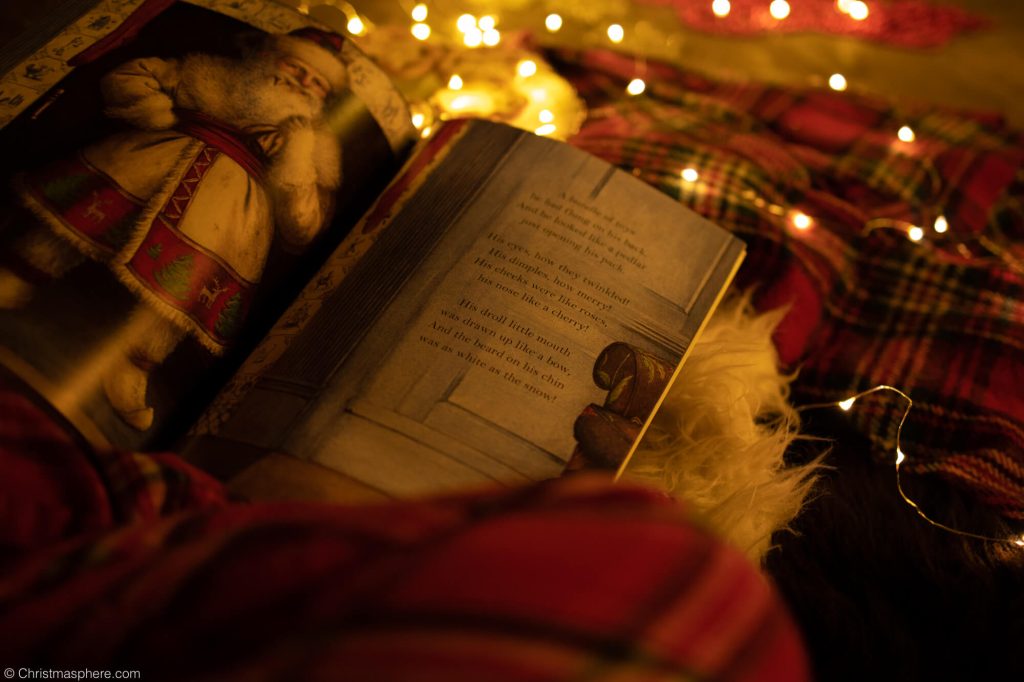
Santa Claus
Santa Claus – The tradition of Santa Claus, originating from the historical figure Saint Nicholas of Myra, has evolved into a symbol of joy, gift-giving, and the spirit of the holiday season globally. From his transformation into the jolly figure in red and white, to regional variations and modern interpretations, Santa Claus remains an integral part of Christmas celebrations. Key traditions include his North Pole workshop, writing letters to Santa, the “naughty or nice” list, and leaving out food for Santa and his reindeer. Santa’s presence is also felt in popular culture and charitable works. Newer traditions such as Santa tracking, Santa parades, and adapting Santa into other cultures further enrich this beloved holiday figure’s narrative.
Saturnalia
Saturnalia – Saturnalia was a significant festival in ancient Rome, celebrated with feasting, merriment, gift-giving, and temporary social role reversals. This festival, dedicated to Saturn, the god of agriculture, liberation, and time, was a tool for social cohesion, providing rest and strengthening communal bonds. Saturnalia’s influence continues today, particularly evident in contemporary winter solstice celebrations, embodying a deep cultural significance transcending its historical context.
Stir-Up Sunday
Stir-Up Sunday – Stir-up Sunday is a time-honoured UK tradition marking the start of Christmas preparations, rooted in the Anglican Church’s Book of Common Prayer. This communal event, celebrated on the last Sunday before Advent, revolves around families coming together to stir the Christmas pudding mixture, make wishes, and embrace the symbolic ingredients that hark back to religious narratives. Despite modern lifestyle changes, the day continues to resonate with many, symbolising unity, shared hopes, and festive anticipation.
Tree Toppers
Tree topper – The Christmas tree topper is a significant tradition dating back to the 19th century, originally symbolising religious aspects of Christmas with symbols like angels or stars. Over time, this tradition has evolved and diversified, encompassing a variety of designs, themes, and personal or cultural significances, making it a cherished part of holiday celebrations worldwide. The topper not only completes the aesthetic of the Christmas tree but also symbolises family traditions, shared history, and the spirit of the holiday season.
Upside Down Christmas Tree
Upside Down Christmas Tree – The Upside Down Christmas Tree is a unique tradition rooted in Central and Eastern European history, with origins dating back to the 7th century where it was used to explain the Holy Trinity. Despite periods of declining popularity and some controversy, the upside-down tree has resurged in modern times as a space-saving measure, an artistic expression, and a reminder of historical and religious symbolism.
The Wise Men
Wise Men – The Wise Men, or the Magi, in the Christmas story represent a significant acknowledgement of Jesus as a universal king, marking the revelation of Jesus to the Gentiles. Their journey, following the Star of Bethlehem and presenting symbolic gifts, greatly influences Christmas traditions, inspiring the practice of gift-giving, the depiction of the star atop Christmas trees, and the narrative retold in Nativity scenes globally.
White Christmas
White Christmas – A white Christmas, characterised by snowfall, is an iconic part of the holiday season in many parts of the Northern Hemisphere and has become deeply ingrained in global Christmas culture. Traditions typically include building snowmen, partaking in snow sports, decorating homes against the beautiful white backdrop, and enjoying warm drinks and comfort foods. Regardless of geographical location, the spirit of a white Christmas encapsulates joy, togetherness, and the magic of the season.
Wassailing
Wassailing – Wassailing is a traditional English practice with roots in pre-Christian times, combining singing, drinking from a shared wassail bowl filled with hot, mulled punch, and wishing good health upon others. Variants include house-to-house wassailing, similar to modern caroling, and orchard wassailing, intended to bless apple trees for a good harvest. Today, while most commonly observed in rural parts of England and North America, it is also increasingly celebrated in urban areas as a festive way to strengthen community bonds and share good wishes for the upcoming year.
Xmas
Xmas – Xmas is an abbreviation for Christmas with roots in ancient Greek and Latin languages. The ‘X’ represents the Greek letter Chi, which is the first letter of the Greek word for ‘Christ,’ while ‘mas’ is an abbreviation of the Latin word ‘missa,’ meaning mass. Despite perceptions of secularisation, Xmas has been used by Christians for centuries as a respectful and convenient shorthand to signify the celebration of Jesus Christ’s birth.
Yule Goat
Yule Goat – The Yule Goat, or Julbocken, is a traditional Christmas symbol in Nordic countries, with its origins in pre-Christian pagan celebrations of the winter solstice. Over time, the Yule Goat has evolved from a sacrificial symbol of the Norse god Odin to a gift-giving Christmas figure and has inspired numerous traditions including straw goat figures, processions, songs, and more. Today, this iconic figure continues to play a significant role in Christmas celebrations across Scandinavia, featured in decorations, food, drinks, and even charitable events.
Yule Log
Yule log – The Yule log, a tradition rooted in Germanic pagan culture and later incorporated into Christian celebrations, represents warmth, light, and renewal. Its modern adaptations range from televised log broadcasts and log-shaped desserts like the Bûche de Noël to various global traditions and personalised rituals. Despite the changes over time, the Yule log remains a cherished symbol of holiday cheer and a link to our shared past.




